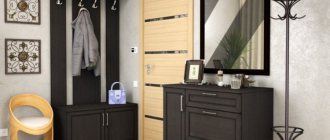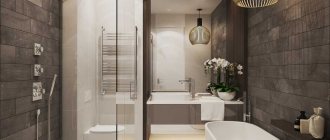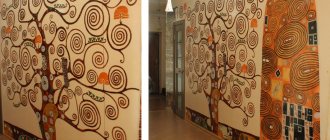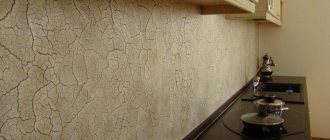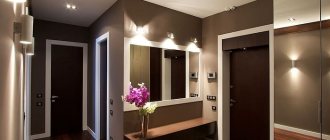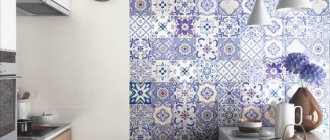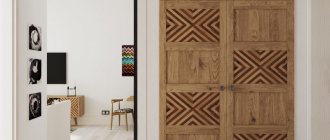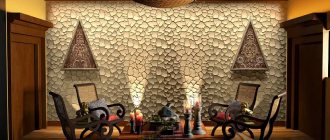Wall finishing is an important stage in renovation; it is especially worthwhile to approach the finishing of the wall in the hallway responsibly. The hallway is the room that guests see first.
It should be as cozy and bright as possible, and shoes and outerwear are also taken off in the hallway, so it should be practical, and the repairs in it should be durable. On the Internet there are a lot of different photos of walls in the hallway, which are covered with different materials.
Brief overview of the article
Materials for finishing walls in the hallway.
There are a large number of materials for decorating walls in the hallway. Each material has its pros and cons, the most popular:
- dye;
- decorative plaster;
- wallpaper;
- fake diamond;
- ceramic tile;
- plastic panels.
In some cases, the design of the walls in the hallway can be made of several types of materials. The main thing is that they combine with each other and fit well with the interior of the hallway room.
What material should be used for the hallway wall?
There are several important nuances that are important when choosing material for wall decoration in the hallway. The selected material should be:
- durable;
- withstands light damage and dirt well;
- light and easy to care for;
- It is desirable that the material can be restored in case of damage;
- tolerated high humidity well;
- safe.
It is also important that the material for covering the walls is beautiful and fits well with the style and design of the room.
Umbrella basket
Wicker baskets for umbrellas in the hallway interior.
A stand for umbrellas can be a wicker basket, a narrow vase, ceramic sculptures in the form of a suitcase, high boots, or openwork forged or metal structures. Such an accessory has a powerful design function and at the same time remains a practical thing. When you urgently need an umbrella, you don’t have to rush to look for it - it’s always in one specific place.
Paint for finishing walls in the hallway
Painting the hallway walls with paint is the most budget-friendly and easiest option. A wide range of paints allows you to choose the desired color of the walls in the hallway in any shade. As a rule, warm pastel colors are chosen.
It is worth noting that in order for the paint to adhere well to the walls, they must be well prepared and as smooth as possible, otherwise all the flaws in the wall will be noticeable.
Decorative plaster
Textured plaster in room design.
This method of wall cladding is almost the most successful. It combines rigor, simplicity and elegance, as well as ease of application. This design can be combined with any type of ceiling and any floor covering and suits every interior style. Even a novice designer can cope with such a task. The corrugated structure is selected to taste and painted in any suitable color. If desired, you can create entire compositions of paintings on the walls, realizing ideas that have long been in your head.
Wallpaper on the hallway walls
Decorating the walls with wallpaper in the hallway is the most popular option for any style. There are many options and designs for this material. For the hallway it is better to choose vinyl or non-woven wallpaper of good density.
You can also use liquid wallpaper, glass wallpaper and photo wallpaper. Some wallpapers are washable, making them easy to maintain and can also visually expand a space or ceiling height. Wallpaper is durable in use and most of them can hide minor defects and unevenness of the wall.
Plants
Rounded arch with trim in the hallway.
Such decor is unlikely to be appropriate in cramped hallways of small apartments, but will be an excellent option for spacious hallways of private houses, which often accommodate entire furniture sets, stained glass windows, columns and other architectural excesses. Flowers give coziness, add freshness and life to the room. Planted in beautiful themed pots that match the style, they will noticeably decorate the entrance room.
Artificial stone on the walls of the hallway
Decorating the wall with stone in the hallway looks very beautiful and unusual. This material is considered environmentally friendly and as safe as possible. Artificial stone can withstand high humidity well, is quite strong and durable to use, and is easy to keep clean.
Very often, this coating is combined with decorative plaster or paint, since artificial stone is quite expensive and it is not always possible to cover all the walls of the room with it.
Design of hallways with drawings (photos of interiors)
Similar articles
- Hallway storage: pantry drawer, shelf decor, hallway space and DIY photos, shelving and accessories
The organization of the hallway should be thought out to the smallest detail. It has long been known that a room begins to be assessed from the hallway, so its design should be... - How to decorate wallpaper with your own hands: decor, stickers, stencils, painting, combinations, combinations and instructions for work
Wallpaper stickers are the most inexpensive and effective way to decorate them. Do-it-yourself apartment renovation is an exciting and responsible event,… - What wallpaper to choose for the hallway: how best to glue it, photos, which ones are suitable, choose the color, stick it in a small room correctly, paste it, video
The hallway should tell more about its owner than he himself can. The hallway is the most important room in every house: this is where all the guests find themselves...
Plastic panels on the walls of the hallway
Very often, plastic panels are used to cover hallway walls. This material is budget-friendly and comes in a wide range of designs and colors.
The interior of the hallway walls can be made to suit any style using plastic panels. Covering walls with this material is quite simple and easy; you don’t need to level or prepare the walls much. Plastic panels can be cleaned wet, but it is worth noting that they quickly fade when exposed to direct sunlight, and they can also be easily damaged.
We decorate the hallway with paintings, posters, photographs
Paintings, photographs, posters are a traditional way of interior decoration. May you be greeted by friendly photographs of your loved ones, or the brightest moments captured on film.
Place them in frames throughout the hallway - this method remains popular for a reason - it works. In the same way, you can hang simply beautiful landscapes, views of cities, works of famous photographers. If the size of the hallway and the chosen style allow, hang a painting. Prints and posters are also a good way to decorate your hallway. All this can support the overall style of the apartment. For example, graphics are for minimalism and hi-tech, modular paintings are for Art Nouveau style, posters with plant motifs are for Provence. Focus on your taste and remember an important rule: the brighter and more expressive the image on the canvas, the more modest the frame should be.
Tips for decorating hallway walls
Experts give some good tips and recommendations for decorating walls in the hallway:
- 1. The material must be practical and environmentally friendly.
- 2. You should not give preference to very light tones.
- 3. It is best to give preference to a material that is easy to care for and can be cleaned with wet water.
- 4. When deciding to decorate the walls with several types of materials, you need to take into account that they must match each other in style and design.
- 5. In order to visually increase the height of the ceiling, you can use wallpaper with vertical stripes.
- 6. In order to hide dirt on the walls as much as possible, you can cover the bottom in a dark color, and the top in light colors.
Corridor lighting
Ceiling decoration using LED strips.
Switches, power supplies from LED strips, multi-level lighting are planned and installed at the stage of preparing the walls and ceiling. Everything here is individual and depends solely on the preferences of the owner.
A tablet chandelier will be a good solution for a small room - it will not steal space, but will provide powerful light. Multi-level lighting with a power relay will allow you to adjust the amount of light depending on need, and at the same time save on electricity. For spacious hallways, a chic, weighty chandelier would be appropriate if the room is decorated in a classic style. Hanging lamps of regular geometric shapes are suitable for high-tech or modern. It is quite possible to combine several lighting fixtures. A sconce near the mirror and a chandelier in the center of the ceiling. Framing with ribbons around the entire perimeter, not only the ceiling, but also the floor or around furniture accessories is also an interesting solution.
Lighting the corridor with a lamp.
The modern market also offers luminous panels that turn on with a light touch of your foot. And besides, you can make lampshades with your own hands from available materials, making the room truly unusual.
Color spectrum
When choosing a palette, it is important to focus not only on personal preferences, but also on the size, shape, and features of the hallway. For example, cold silver and gray tones are suitable for small rooms, as well as ivory, which will visually raise the ceiling.
Long corridors also need to be adjusted. To correct the proportions, use white and light colors, as well as prints in the form of horizontal stripes, which will cope with this problem. Large spaces also require a special approach and warm colors. There are several tonal options.
Dark colors
They set a certain mood, while adding refined and elegant notes. Often this background becomes an ideal option for furniture compositions. In addition, each item is visually emphasized without creating dissonance. Art Deco, Art Nouveau, and fusion work perfectly with dark colors, creating a real masterpiece.
It is believed that such a decision will make the overall atmosphere gloomy and inappropriate. But the right lighting and furniture work real miracles, creating an elegant, expensive, luxury interior. Colors such as cobalt, violet, indigo, burgundy, and dark blue look great.
Light shades
The main feature of this tint is the ability to adjust the space and make it lighter and more spacious. In addition, any of the palettes in this category can be perfectly combined with hundreds of colors and shades, also allowing you to correctly place all the necessary accents.
For a fresh, calm, clean interior decoration, light green, lilac, blue and other pastel colors, as well as beige and ivory, are well suited. It is these shades that will provide the necessary coziness and homely atmosphere, add volume and warmth, light and comfort.
Using specific scales
Monocolor in design involves using shades of the same color for all surfaces and elements with the addition of just a couple of accents. For example, chocolate brown solutions demonstrate conservative tastes, since wood is predominantly used.
The rich gray scale is quite noble, and not faceless, as many people think. Practical gray color has a positive effect on the atmosphere, and the decor will be especially pleasing in graphite, pearl, light metallic tones with a pleasant shine.
As for only white, it needs to be diluted with wood for comfort. And, you need to remember that it shows the most dirt and even fingerprints. The beige monocolor is a representative of the classic trend, but mint will add unexpected freshness.

